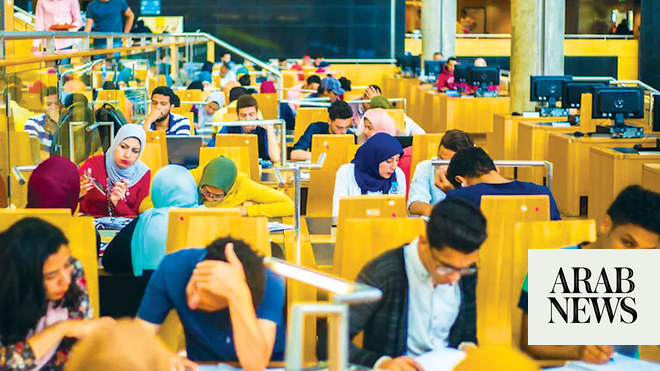
Population of young people in MENA region expected to reach 65 million by the end of 2030
Young people employed in productive activities boosts the demographic dividend
DUBAI: The Middle East and North Africa region is experiencing a “youth bulge,” which occurs when young people make up a disproportionately large percentage of the population.
Although the crest of the demographic wave is believed to have passed in most Arab countries, the population of young people in the region as a whole is expected to reach 65 million by the end of 2030. Whether the countries concerned will be able to harness what remains of this phenomenon, however, is an open question.
The phrase “demography is destiny,” often attributed to the 19th-century French philosopher Auguste Comte, underscores the importance of demography to the development of everything from communities and nations to political economies.
A youth bulge can become a “demographic dividend” if the swelling ranks of working-age young men and women can be employed in productive activities, raising the level of average income per capita.
However, if most of the adults entering working age cannot find jobs and earn a satisfactory income, the frustrations resulting from high youth unemployment could grow into a security challenge.
Be it in the Arab world or any other region, a large youth population is therefore a mixed blessing when it comes to employment and educational opportunities, economic growth, and social and political stability.
According to a 2022 World Bank report, “Jobs undone: Reshaping the role of governments toward markets and workers in the Middle East and North Africa,” one in three (32 percent) of young people aged 15 to 24 in the MENA region are unemployed and not engaged in education or training.
In fact, the region’s young workers face the highest unemployment rates in the world, averaging 26 percent, reaching 30 percent in Algeria and Tunisia, 40 percent in Jordan, and surpassing 50 percent in Libya.
“The landscape in the MENA region varies a lot from country to country, with some being very much ahead in addressing labor-market issues and many others lagging behind,” Roberto D’Ambrosio, CEO of Axiory Global, told Arab News.
This makes the youth employability issue “a very difficult one to tackle, turning a great advantage and asset, which is represented by a very high percentage of young people, into de-facto a liability.”
D’Ambrosio pointed to “bureaucratic hurdles and rigid labor-market regulations” as factors that often hinder job creation and discourage private investment, making it difficult for young people to find work.
“In the most affected countries the main reason for youth unemployment is to be found in insufficient economic growth and diversification, in excessive bureaucracy and short-sighted protectionist policies, which along with some level of local hurdles, make it difficult for foreign-led investment to consider engaging those jurisdictions.”
Other challenges include a mismatch between education and the job market, and the types of employment on offer.
For example, informal employment is estimated to be as high as 77 percent of the total figure in Morocco, 69 percent in Egypt, 64 percent in the occupied Palestinian territories of West Bank and Gaza. By contrast, the rate is as low as 16 percent in Bahrain.
Informal employment often refers, among other cohorts, to domestic workers, street vendors, waste pickers and home-based workers such as garment makers, who are neither taxed nor monitored by the government.
“Informal employment lacks the same investment in talent and equal benefits as formal jobs,” Sonia Ben Jaafar, CEO of Abdulla Al-Ghurair Foundation, told Arab News.
Another critical issue in the data concerns women, accounting for just 20 percent of the MENA workforce, making it the lowest in the world. “Gender disparity is one of the many reasons a lot of young female youth are not a part of the existing workforce,” she said.
Not every MENA country is struggling to boost employment opportunities. Successful strategies in Saudi Arabia and the UAE, for instance, are helping these countries to diversify their economies beyond oil, invest in innovation hubs, and prioritize educational reforms that align with job-market needs.
“Emiratization policies have also shown some promising results, with more than 50,000 Emiratis joining the private sector in 2023 alone — exceeding the strategy’s expectations and broadening avenues for the workforce,” Ben Jaafar said.
FASTFACTS
World youth unemployment rate was 15.58% in 2022.
75 million young people worldwide are trained but have no job.
In the next decade, 1 billion young people will enter the labor market.
Young people about 3 times more likely to be unemployed than adults.
Aug. 12 was International Youth Day.
It is no secret that many MENA economies rely disproportionately on extractive industries such as oil and gas, which experts believe is a major reason for the currently limited supply of employment opportunities beyond these sectors and government-backed entities.
“Economic diversification is crucial to creating a range of employment opportunities for the youth,” D’Ambrosio said. “This is being addressed with the deployment of massive investment in countries such as Saudi Arabia and the UAE.”
For example, Saudi Vision 2030 includes initiatives to reduce youth unemployment by boosting private-sector growth, promoting an entrepreneurial culture, expanding vocational and technical training, and encouraging investment in a range of new industries.
Similarly, the UAE’s National Program for Emiratization aims to increase the participation of nationals in the workforce and offers training and development programs to enhance the employability of Emirati youth.
“The UAE has become a very attractive jurisdiction for skilled and experienced professionals from North America, Europe and Asia,” D’Ambrosio said. “As time passes, such skills and experiences will be passed on to the local workforce, allowing greater employability of UAE nationals and residents.”
Additionally, the UAE and Qatar have sought to position themselves as international education hubs by attracting reputable institutions to establish schools and colleges. For the wider region, however, educational inequality remains a problem.
Nidhal Guessoum, professor of physics, astronomy and space science at the American University of Sharjah, believes the MENA region’s education sector is struggling to keep pace with rapid technological developments.
“People then fall victim to those developments. New graduates, dropouts and employees who are laid off because their jobs are no longer needed. And with the coming of age of artificial intelligence and its replacement of human workers, this trend will continue and accelerate,” he told Arab News.
“The education system in our region is notoriously sluggish and resistant to changes, yet we still focus on teaching content and ‘knowledge’ rather than skills, methods and possibilities.”
To help resolve this problem, Guessoum says governments must assemble standing committees of experts to constantly review trends in the world economy and advise on modifications to national curricula and industry.
Failure to adapt will only swell the ranks of unemployed young people as their skills fall short of current and future industrial requirements. According to Axiory Global’s D’Ambrosio, “there seems to be insufficient demand from regional organizations to employ those young people seeking employment.”
This translates into more young people joining the hunt for jobs, making it even more challenging for them to stand out individually to potential employers and secure a decent wage.
A 2019 report published by the IMF found that in most regions of the world, the duration of unemployment is shorter for young people than for adults, reflecting the natural tendency of youth to move between jobs more frequently.
However, in most MENA countries, youth unemployment appears to be the result of waiting for the right job. This means periods of unemployment may be longer on average, especially for educated youth, who may require more time to find a good job to match their skills.
“This is an important point, because it is the duration of unemployment, rather than its occurrence, that is most detrimental to human capital accumulation,” the IMF report said.
Placing the MENA ‘youth bulge’ approaches in perspective, Ben Jaafar said regional leaders are pivoting to more sustainable solutions that promote inclusion and create skill sets that are more fluid and flexible to match a changing economy.
“We are already starting to see policy shifts with respect to diversifying education-to-work pathways, as seen by the UAE Ministry of Education, which has already been open with its welcoming of online modality and consideration of stackable courses,” she said.
However, schools and colleges need to be equipped to implement engaging upskilling programs and initiatives that go beyond mere “employability.” Only then will young people be able to leverage their technical skills within various industries, Ben Jaafar said.
“To do this, we should not reduce educational leaders to job-certification professionals. They are cultivating a generation of critical thinkers to solve serious problems with our climate, our industry, our social connections, and all those pieces of our society that are at risk.”
Across the Arab world, she said, the youth unemployment problem is “complex and multifaceted,” a result of several external factors besides weak education systems.
The saving grace, according to Ben Jaafar, is that the current generation of young adults has the privilege of technological advancements and a variety of resources to guide their decisions.
“They realize the importance of education and want to succeed in life,” she said. “But they require proper guidance and pathways to be successful and be able to give back to the community.”












